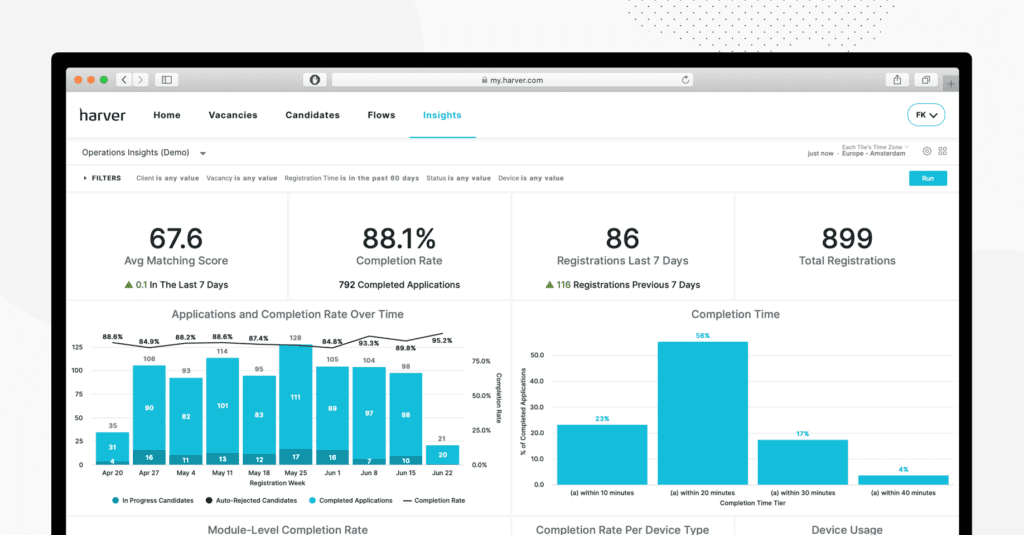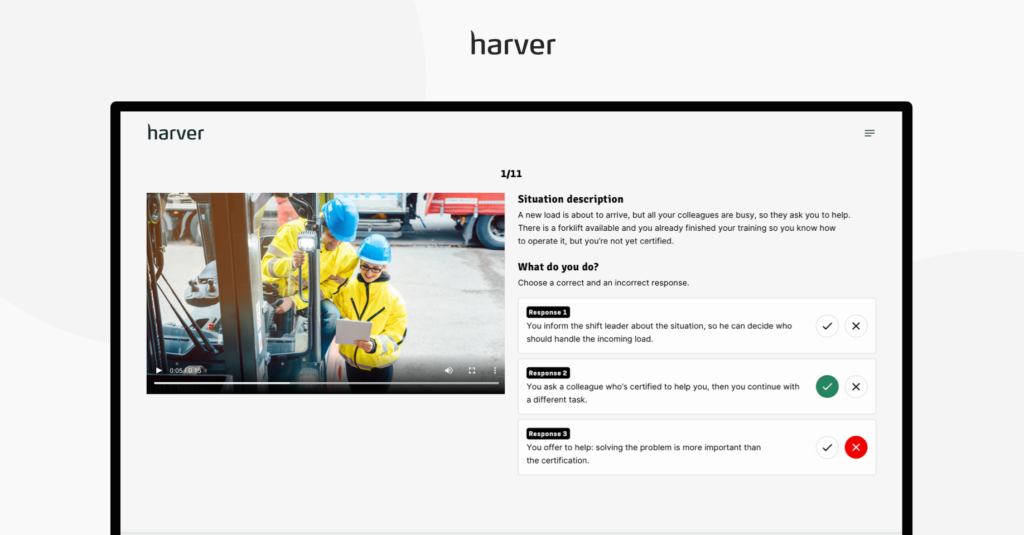High volume recruiting in any industry can be a challenge, but when it comes to manufacturing, finding enough skilled workers to fill your open positions requires strategy.
Because manufacturing positions often require experience as technicians, plant managers, or assemblers — all positions that require extensive training — you need to know all the ins and outs of volume hiring in manufacturing before you start your hiring process.
What’s in?
The pandemic’s effect on the manufacturing industry
The pandemic has severely impacted the manufacturing industry, shutting down factories and disrupting the supply lines. The demand for multiple categories of industrial products dropped, forcing companies to cut operational costs. At the same time, sectors such as food or health care – both producing crucial supplies – scaled up production to meet the increasing demand for vital goods, including pharmaceutical and personal care products.
All over the world, manufacturers had to revamp their employee safety measures and implement social distancing measures almost overnight. However, a lot of factories were not designed for remote work and lacked the infrastructure and the digital tools needed to support a remote-first operating mode. This created additional issues, making it challenging for manufacturers to retain all their on-site workforce and leading to the lowest employment levels since 2010.

543k
lower manufacturing employment levels in December 2020 compared to February 2020.
Source: Deloitte
Now that things are slowly going back to normal, executives are looking not only at ways to retrain and retain their workforce but also at implementing hybrid work models for their production and non-production processes, to manage uncertainty and be better prepared for future disruptions.
The challenges of high-volume hiring in manufacturing
Despite the rise in the number of unemployed people as a result of the Covid-19 crisis, skills shortages continue to be a challenge for manufacturing companies. These are caused by the decreasing number of people who choose to pursue education in this sector, coupled with the aging and retiring workforce and the tight labor market.
Also, more and more manufacturing roles are becoming increasingly technical, which leads to skills gaps and creates additional challenges for recruiters. On top of this, manufacturing jobs are not seen as particularly attractive by the younger generations; in fact, the modern workforce has a negative perception of working in this sector.

45%
of prospective younger employees have a negative perception towards the manufacturing industry.
Source: Deloitte
But the lack of skilled candidates isn’t the only challenge for TA leaders and recruiters operating in this industry. According to a PwC survey from 2020, manufacturing companies struggle with retaining critical talent, managing employee morale and well-being, and building skills for the future.
Moreover, the industry is struggling with high turnover rates, the average annual turnover for manufacturing companies being 20%. And given the rapid rate of Baby Boomers retiring, the future doesn’t look too bright: multiple reports estimate that nearly 2.1 million manufacturing jobs will go unfilled through 2030.

20%
is the average employee turnover rate in the manufacturing industry.
Source: thefabricator.com
The vast majority of these are expected to be entry-level production associate positions, which don’t require too much technical know-how or industry knowledge. Although such roles could, in theory, be filled by graduates or employees recently displaced from other industries, manufacturing execs say that finding talent for these positions is 36% harder now than it was in 2018.
Finally, the digital transformation of the industry is accentuating the skills gap, making it even more difficult for manufacturing recruiters to fill the open positions. According to a survey by Deloitte, 75% of industrial organizations identified reskilling their workforce as important or very important for their success over the next year, but only 10% said they were ready to address this need.
How can manufacturers overcome these challenges and develop a workforce strategy that enables them to attract new talent for their open roles, while retaining their middle-skill employees for longer?
What does recruiting in manufacturing look like?
Regardless of the positions we’re referring to, entry-level or middle-skill, you can’t simply hold mass hiring events in manufacturing. When your employees will be working with equipment that might cause an accident, even if their responsibilities are limited, you want to ensure you’re hiring team members who are qualified for the job with minimal training, or who at least have the right attitude for such roles.
So, how do you do that? Here’s an overview of what the volume hiring process might look like:
- Determine evaluation requirements. The first step of any volume recruiting process is to figure out what you’re looking for and how you’re going to judge if a candidate meets that criteria or not. When you’re hiring en masse, you need to have clear guidelines to make the process quick and efficient.
- Implement your tech stack. When you’re going to be working with a lot of resumes, interviews, and hires, you need to have an efficient system to keep everything organized. In most cases, this can’t be done manually. Get your tech stack up and running before you begin the volume hiring process.
- Attract applicants. Posting your open position is a great start, but when you need lots of applicants quickly, you need to make sure you’re posting your openings as much as possible. Creating an applicant attraction strategy that includes some more creative ideas. Ask for current employees to share with their networks. Look for groups or online boards that might post your position, and make the most out of social media.
- Screen your potential hires. After an application comes in, it’s time to see if that candidate is a fit. But when you’re hiring a mass number of employees, this needs to be an efficient process. Consider investing in recruitment automation – but more on this later.
- Establish an efficient interview process. When interviewing in volume, it doesn’t always make sense to have one-on-one conversations. When it makes sense, consider group interviews to get to know who is qualified for the position. Establish who will be conducting those interviews, what team members or managers need to be present, and what you’ll evaluate candidates on to move them to the next round.
- Hire and onboard your new employees. The final step of the recruitment process is to bring your new hires on board. Get your new team members up to speed with training, orientations, and other events so they can hit the ground running on their first day at work.
Like what you see?
Don’t miss out. Subscribe to our quarterly digest to get the latest TA and TM resources delivered right to your inbox.
How should you approach volume recruiting in manufacturing?
While the volume recruiting process might not seem that much different from your standard hiring process, it can quickly become overwhelming when trying to run dozens (or even hundreds) of hires in tandem.
Here are five of our best tips to properly manage the volume recruiting process in manufacturing to make it more efficient.
1. Automate where you can
Finding opportunities to use automation can take the repetitive, mundane tasks off your plate — freeing up your time so you can focus on more important things. Automation can also reduce time to hire, helping you improve process efficiency and create a more agile recruitment process.
Automation also makes it easier to scale your hiring process when you need new hires, providing flexibility and agility. As you scale up and down, you can rely on automation to handle some of the workload for you — but you don’t want to depend too much on automation.
Recruitment automation is best used at the early phases of hiring when you’re weeding through resumes and trying to assess your candidates’ skills. When candidates get further down the hiring funnel, you’ll want to step in to manually evaluate if they’re right for the job. Think of automation as a way to get the busy work done, but it shouldn’t be all you depend on to make your hiring decisions.
We’ve detailed the topic in the articles below.
2. Screen candidates with matching technology
When volume hiring, you’re likely to hire for a number of different positions. For example, if you’re hiring for a new plant that has opened up, you’re probably looking for employees of all skill levels with different experiences. But with so many open positions, a candidate might not apply for the job they’re actually the best fit for.
Using matching technology to screen applicants can prevent those candidates from falling through the cracks. Instead of just looking at a resume to see what experience the candidate has and discarding them for not being a great fit, matching technology can look at their skills, characteristics and fit for the company as a whole and recommend the individual to another position if that fit that description better.
Here’s, for example, a candidate profile with matching scores in the Harver platform. Recruiters can see how well candidates fit specific roles, as well as what their top skills and characteristics are. This candidate selection technology makes it easy to identify the people who are the best fit for the current openings and have transferable skills.

Because matching technology puts skills at the forefront of the hiring process, it also ensures you’re hiring the best person for the job – not just the person with the most experience. Bringing someone on board who fits the culture and expectations of the company can create a better employee experience that keeps them around longer.
Stop guessing,
Start data-driven hiring.
Learn how you implement a modern candidate selection process, that is: streamlined, experience-driven and backed by data.

3. Create a data-driven hiring process
Volume recruiting is all about optimization. In order to source better candidates for future hires, you need to understand what worked and what didn’t. Using recruitment analytics to track your hiring metrics can help you do just that.
With a data-driven hiring process, you can become more efficient in the way you hire — something that is incredibly important when it comes to volume hiring. Using your data, you can figure out what job boards lead to the best hires, how to reduce your time to hire, and what you can do to attract more high-quality candidates to your open position.
Determine what key performance indicators (KPIs) are most important to you. Do you need better quality candidates? Do you need to hire candidates faster? Are hired employees not sticking around very long? First identify the problem you’d like analytics to help solve, then work backwards to figure out where you can improve.
Also, make sure you’re not collecting more data than you need. While it might sound like a good idea to track everything that can be measured and tracked, this can quickly make the data analysis process overwhelming and prevent you from actually extracting actionable insights from your metrics. A good solution is to define your metrics and then visualise them through dedicated dashboards.
For example, in the Harver platform, recruiters can see their recruitment operations insights, candidate experience insights, D&I metrics, and so on. The dashboards are simple enough to be easy to read and understand, but comprehensive enough to offer the insights that TA teams need to make data-driven decisions.

4. Improve your candidate experience
One of the biggest mistakes a hiring manager can make is not considering the candidate’s experience throughout the process. If the candidate is struggling to understand the job, having difficulties applying for the position, or doesn’t feel welcome during the interview process, high-quality candidates could end up leaving to work for the competition. In fact, the misaligned candidate expectations are one of the top reasons for early employee attrition in most industries.
Candidate experience needs to be considered at every step of the process. First, make sure your job previews are accurate and realistic. Explain the day-to-day of the job, what the hire will be doing, and what is expected of them. This can help filter out candidates who aren’t qualified.
For example, for entry-level manufacturing roles, the application process could include some situational judgment tests that offer candidates a realistic job preview, and ask them how they’d react in specific, life-like situations. Such assessments are entertaining, informative, and help manage candidates’ expectations, so they lead to an overall better application experience.

But you’ll also want to look for opportunities to improve the candidate experience throughout every stage of your hiring process, not just at the beginning. It’s important to make candidates feel special and welcome, even when you’re hiring dozens of people at the same time. Personalization can go a long way!
5. Remember company culture
When you want to get a lot of employees onboarded quickly, seemingly less important things can fall to the wayside — one of those being company culture. But if you hire someone who isn’t a good fit for the company, they’re likely to leave and you’ll be stuck replacing them in a matter of months.
Don’t push company culture to the side in order to get more hires. Make sure you’re appropriately communicating how the company functions and what is expected out of employees. Share your company values and overall business goals to hire candidates who align with those same values.
You can embrace company culture through social media, videos included in the application flow, or a cultural-fit assessment added to the recruitment process. If a candidate doesn’t feel like they’re a match for the company, they can weed themselves out early on before too much time is invested in them.
Next steps
Even with best practices in place, volume hiring is difficult without the right technology backing you. Trying to manage applications manually results in high-quality candidates falling through the cracks, confusion on the candidates’ part, and difficulty keeping track of all your skill assessments and candidate documents. And without software, trying to manage analytics and KPIs is nearly impossible.
Harver makes it easy to manage thousands of applications so you can streamline your volume hiring process and select the best candidates for your open roles. Our software uses four building blocks – matching technology, automation, business intelligence, and candidate experience – to create an engaging recruitment process that’s fast, efficient, and enjoyable for the applicants.
Ready to transform your hiring process?


